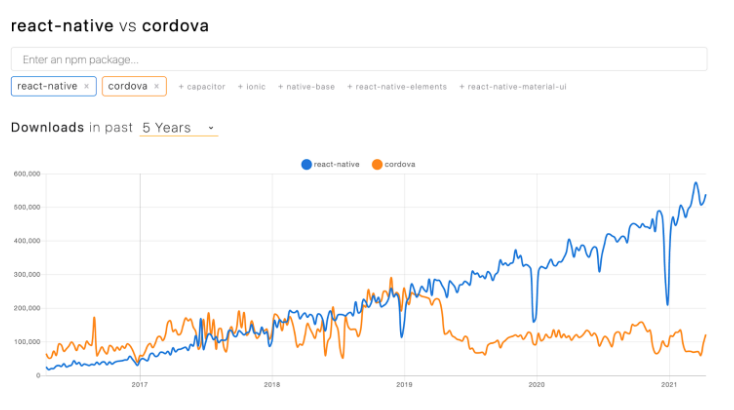
Why You Should Migrate from Cordova to React Native
Cordova and React Native are two of the most popular frameworks for hybrid app development. However, many developers are turning to React Native to build their applications. In this article, we’ll break down some of the pros and cons of each and explain why React Native is often the better choice.
Table of Contents
Mobile application development continues to evolve as older technologies make way for newer, more efficient frameworks that speed up the development cycle and help mobile app developers make better quality applications faster.
According to Statista, global smartphone penetration went over 46% in 2020. Given this growth, businesses continue to look for ways to appeal to different audiences with the help of a mobile app. For any successful mobile application, it needs to be available on iOS and Android. However, creating a native application for either platform can require lots of investment due to their differing guidelines and software development tools. Rather than building two separate mobile development teams and, with the added benefit of reducing costs while lowering time to market, many businesses instead opt for hybrid app development.
Developing a hybrid application blends a native mobile app and a web app using HTML, CSS, and JavaScript. Given the popularity of JavaScript for web development, developers have a wealth of experience building mobile applications using the language. However, just as with web development, a choice must be made between the frameworks you use to develop the application.
Cordova and React Native are two of the most popular frameworks for hybrid app development. However, many developers are increasingly turning to React Native to build their applications. In this article, we’ll break down some of the pros and cons of each and explain why React Native is often a better choice than Cordova.
What Is Apache Cordova?
Apache Cordova is an open-source framework for building mobile solutions. Cordova makes it easy to build mobile applications for any mobile device, whether iOS, Android, Windows or another platform. Apps run in a WebView shell so, essentially, web code runs in a mobile browser, giving apps a somewhat native feel.
Cordova provides a great option if the project you’re building requires both a web and mobile application. It enables you to use the JavaScript library of your choosing to help develop the application. Cordova is also easy to grasp for developers who have experience building web applications.
Note that Cordova has been around for many years and has not always been actively maintained. As a result, the people behind Ionic, a popular mobile web framework, released Capacitor in 2018 with the goal to modernize and improve on Cordova. It has many advantages including a more modern architecture, native PWA support and better handling of native web APIs. It even supports many Cordova plugins out of the box. We will continue to talk about Cordova in this article, but recommend that you take a close look at Capacitor as an alternative if you are planning to go the Cordova route.
What Is React Native?
React Native is an open-source framework developed by Facebook for building cross-platform mobile applications. React Native features are similar to those of the web development framework React, and it also relies on JSX and React components for building applications.
With a simple interface and tooling React Native is easy for developers to work with. However, it does require that developers have some familiarity with React already, which means that it might not be the first choice for junior developers or those looking to build the most straightforward mobile applications. But this familiarity with React also means that developers can draw on the expertise of the larger React community when facing challenges.

Cordova vs React Native
Making a choice between Cordova and React Native can come down to a few different factors and how each framework approaches specific things. Let’s highlight the differences and show where React Native has the advantage.
Popularity
When it comes to popularity, React Native outshines Cordova by quite some margin. With the popularity of React as a JavaScript framework, developers who know React can quickly learn React Native and extend their knowledge to the mobile application realm.

A quick comparison on npm trends of the number of downloads of both React Native and Cordova over the last five years indicates that React Native has been steadily increasing in popularity since 2019. In contrast, Cordova has been steadily decreasing in popularity. This suggests that developers are favoring React Native for mobile application development.
Winner: React Native
Performance
While React Native and Cordova both make it easy to build mobile applications, they don’t perform to the same level. Cordova’s ability to create cross-platform applications makes it advantageous for companies that want a simple option, but what they gain in flexibility they can lose in performance. Hybrid applications built using Cordova can be slow compared to native applications, which can be a significant problem given the importance of speed and responsiveness for consumers today.
On the other hand, React Native provides a much faster app performance that matches up closely to a native mobile application.
Winner: React Native
Look and Feel
Cordova makes it easy to turn web applications into mobile applications and can be a less costly alternative to building native mobile applications. However, when it comes to the look and feel of the interface, it doesn’t always match up with a native application. On the other hand, React Native facilitates the development of applications that are much closer to the look and feel of native iOS or Android applications.
Winner: React Native
Web & Mobile Code Reusability
While React Native shares many of the same concepts with React, developers can’t simply take the code they used to build a web application and repackage it for mobile. On the other hand, Cordova makes it easy to bundle an existing web application into a Cordova application and reuse the same code.
Winner: Cordova
Choosing React Native Over Cordova
Both React Native and Cordova allow developers to build mobile applications that enable companies to make their mark in the ever-growing mobile development market. With different philosophies, each has its unique advantages under certain circumstances. However, as we’ve highlighted, React Native wins out in quite a few key areas.
Going with React Native as your mobile development framework of choice is a good idea in today’s current environment. Yet, you still need to have the right skillset if you want to maximize the capabilities of React Native.
At Salsita, we have extensive experience creating dynamic mobile applications using React Native, giving our clients the look and feel of a native iOS or Android application while relying on fewer resources. By using React Native, we can also increase the scalability and improve functionality as the application grows. Popular apps such as Instagram, Airbnb, and UberEats have already been built using this impressive technology.
If you’re ready to learn more about how you can benefit from using React Native for your mobile app, then contact us to get started.










